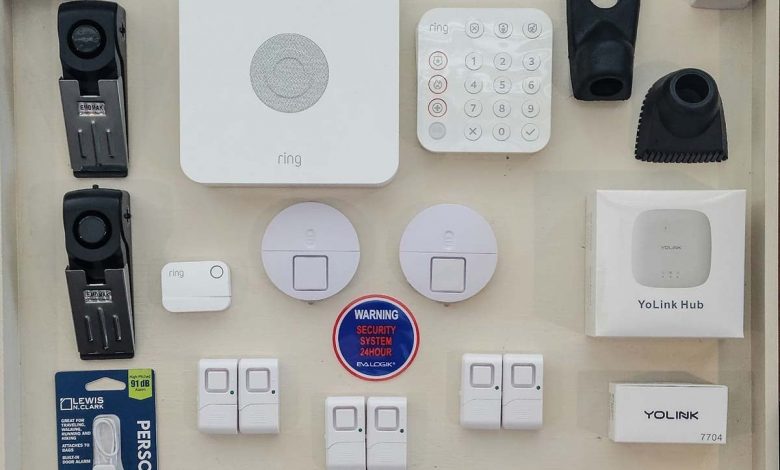Best Door and Window Alarms [Top 7]

Any home security system protects the home and its residents from theft and property harm. A loud alarm that scares off attackers and alerts residents is the most significant security for many households. Some desire a comprehensive system that detects motion, records activities and sounds a siren.
The latest door and window alarms are loud, sensitive, and convenient—but which ones are best? We examined popular products to see which had the best warnings. After installing them on doors and windows, we listened to their loud alarms.
A shopper’s ideal alarm depends on their preferred type, installation location, and remote access needs. Discover the numerous types of door and window alarms and how the following models made our list of the best.
Secure Your Home with the Best Door and Window Alarm
Some features to look for in a door and window alarm system for a garage, house, or business are remote access, pet protection features, and camera access. Also, read Best HVAC Services 2023.
Remote Accessibility
They access a security system from anywhere in the house or when you are away, giving you security and assurance that you can’t obtain with systems that can only be used in one place. Instead of returning home to a loud alarm and a smashed window after the intruders leave, smartphone users can respond immediately. Some alarms have their app, while others use IFTTT to control them remotely.
Users can turn off their security system remotely if they want a friend or neighbor to check on their residence while away. This system usually connects to a home Wi-Fi network and can be operated from a smartphone, tablet, or PC.
Pet Protection
Pet security solutions use cameras to watch and talk to pets. These systems may incorporate pet doors, interior or outdoor motion sensors, treat dispensers, and noisemakers to alert owners when their pets go outside.
Pet security alarms operate like door and window alarms, but their loudness is usually too low to startle the animal. Many smart contact sensors let you disable audible alarms and receive phone notifications. Burglar alarms on doors and windows may also deter animals. They may also annoy pet owners when their dogs bark at squirrels or go potty outside.
Camera Access
A camera can enhance the security of a door and window contact sensor alarm. Record everything you see inside and outside your home. Users can access live feeds from security cameras’ hard drives, websites, or apps.
Cameras usually outweigh alarms. Some camera alarms sound like sirens to deter intruders, while others silently transmit a message to the user’s phone, an indoor receiver, or the police. Some cameras and alarms with remote access and warnings can broadcast signals over Bluetooth up to 150 feet.
Best Door and Window Alarms Tested
We tested alarm-only security solutions rather than cameras or floodlights with alarms. “Also Tested” describes the product that didn’t cut. Our hands-on examinations showed that each of these devices provides valuable security.
1) YoLink Smart Window Door Sensors, LoRa ¼ Mile Range
We found four conventional contact sensors and a hub in the box. The YoLink app made connecting the hub to our Wi-Fi network easy. We discovered we could connect the hub to our wireless network using the Ethernet connection that came with it. That was a good option for anyone with problems syncing the hub wirelessly.
An inside door received a contact sensor. YoLink requested us to name it. “Master bathroom” was the name. The sensor texted us when we opened the door. We installed the remaining sensors on the house’s doors. They all texted us when a door opened. Then things changed.
Despite not opening the doors, we received another phone warning a few minutes later. We checked the app and found the master bathroom door open. The app might notify us if a door was left open for a particular time.
Another surprise awaited. We brought one of the sensors from a door inside the house to our shop, about a quarter mile away. When we opened the business door, our phone let us know. LoRa technology lets the YoLink hub communicate with sensors up to a quarter mile away, unlike Wi-Fi and Bluetooth. Nice.
We liked YoLink alarms but wanted a whistle or siren to alert us when a door was open. That’s a minor issue with a superb long-distance security solution. Alerts require a smartphone or Alexa device. YoLink works with Alexa devices like Echo Shows.
Specifications
- Type: The contact sensor
- Remote access: Yes, receive alerts on a smartphone or Alexa device
- Audible alert: No
Pros
- Peel-and-stick sensors make it easy to put them in place.
- Hub uses radio signals that travel a long way.
- Syncs with YoLink, IFTTT, or Alexa app.
- Hub can be connected to a router or Wi-Fi.
Cons
- No audible alerts from sensors
2) GE Personal Security Window and Door Alarm, 12-Pack
GE’s window and door alarms prove that safety doesn’t cost much. These alerts resemble most contact sensors. The setup is simple with peel-and-stick pads. They’re louder than expected.
Each sensor requires batteries, so we mounted the two sections on the doors, lined them up, and tested them. Each sensor has a side switch for on/off and chime/alarm. The doorbell chime is pleasant and simple to hear from other rooms. However, the alarm damages your ears. We jumped when we opened the door and triggered the alarm. Even though we didn’t have a sound meter, the manufacturer’s 120-dB siren spooked us enough to wear ear protection when testing the sensors.
These GE contact sensors won’t function with a home security system or Wi-Fi, but they’re fantastic for cheap, loud alarms to deter criminals.
Specifications
- Type: The contact sensor
- Remote access: No
- Audible alert: Yes
Pros
- The alarm is deafening
- Optional sound of bells
- Easy to set up
Cons
- Doesn’t work with smart devices or Wi-Fi.
3) Ring Alarm Security Kit, 5-Piece, 2nd Gen
Home security brand Ring makes the Ring Alarm Security Kit. It’s ideal for apartment residents and modest house owners who desire superior security.
We created an account and downloaded Ring Always Home initially. The app guided us through the Wi-Fi setup. The system comprises a hub, range extender, motion detector, keypad controller, and contact sensor. The software made setting them up easy.
We loved how the touch sensor and motion detector alerted our phone immediately. The range extender only extended the sensor by 30 feet. We wanted another touch sensor for another door or window.
The system has three modes: Home, Away, and Disarmed. The motion detector was off in Home mode, yet the touch sensor alerted. The touch and motion sensors alerted us in Away mode. No warnings in “Disarmed” mode. A loud alarm is another option. We estimated 100–105 dB based on the other alarms we examined.
A keypad or phone code might arm or disarm the system. The keypad can be programmed to call the police or fire agency with a single press. We skipped that. The Ring Alarm keypad and smartphone app worked wonderfully. Subscription services offer real-time monitoring. Also, read Best Indoor Security Cameras.
Specifications
- Type: Contact sensor, motion detector
- Remote access: Yes
- Audible alert: Yes
Pros
- Loud siren-type alarm
- Use a keypad or a smartphone to control
- Added a function to detect motion
- Later, more sensors can be added.
Cons
- The range extender didn’t work too well
- There is only one contact sensor.
4) Lewis N. Clark Travel Door Alarm
The Lewis N. Clark door alarm resembles a large keyring. However, its 91 dB alarm will undoubtedly scare an attacker trying to enter through a door or window.
This sensor works differently. It features two top cords. Remove the cord with two steel prongs on the left side of the unit. The alert is silent when the prongs touch. The siren sounds if they separate.
We placed the prongs between the door and door frame and looped the cable over the door handle. This prevents prong pullout. We pressed the “On” button on the unit’s front. The pointy end dropped out when we opened the door, and the alarm sounded loud.
A double-hung window was used to test the Lewis N. Clark alarm. We opened the window outside. We triggered the alarm. We appreciated this alarm’s portability, but the chord was too thin. We wanted something more challenging.
Specifications
- Type: The contact sensor
- Remote access: No
- Audible alert: Yes
Pros
- Compact enough to carry easily
- Doors, windows, and more can use it.
- Loud siren
- There is a tiny pinhole flashlight.
Cons
- Cord seems fragile
5) Eva Logik Door Window Alarm With Vibration Sensor
If the window is locked, a contact-sensor alarm won’t work. A glass-break sensor alarms if the glass breaks. Our Eva Logik vibration sensors had to touch the glass when it broke.
Four sensors with double-sided glass stickers are included. The stickers tell burglars the house is secure. Sadly, our delivery featured only two stickers. This was a mistake. However, we also saw in product reviews that others still need to get all four stickers. Helpful double-sided tape can stick sensors to windows.
Our windows weren’t broken. Instead, we mounted an Eva Logik sensor to a 12-inch-by-12-inch clear glass. Easy. We placed the pane on a towel on the ground outside. A hammer broke it.
The Eva Logik made a terrifying whistlelike sound as the glass broke. Based on the other warnings, we estimated 95 dB. This alarm only detects vibrations. Thus it needs a sensor for each window. A glass-break sound sensor, which detects shattered glass and alarms, may be best for multiple-window security. Also, read Best Memory Foam Mattresses.
Specifications
- Type: Glass break (vibration) sensor
- Remote access: No
- Audible alert: Yes
Pros
- Simple to put on a window
- Possible intruders can see the warning sign.
- Loud whistlelike alarm
Cons
- Only sensitive to vibrations; not sensitive to sound
- There weren’t enough stickers to stick all four sensors.
6) Emdmak Door Stop Alarm With 120 dB Siren
The lightweight Emdmak door alarm is perfect for traveling. It fits in a backpack or duffel and may be wedged under the door. We had to find and install a 9-volt battery in this alarm, the only one without batteries. We closed a door and jammed the Emdmak door stop under it. It has low, medium, and high sensitivity. After turning it on, we chose high to see how little pressure we could apply on the door before the alarm went off.
A loud alarm sounded when we opened the door. Since we left while wearing ear protection, we believe the manufacturer’s 120 dB claim. The device’s medium and low sensitivity settings didn’t vary when we tested them again. The alarm went off without much pressure on any of the three settings. Turning the handle and pushing the door slightly set off the alarm, but knocking didn’t.
This door alarm’s rubber base is non-slip. This makes it harder to force open the door. However, the loud alarm undoubtedly deters most people. This made the user feel safer and more comfortable, whether at home or traveling in a new environment where they could be more frightened.
Specifications
- Type: Pressure sensor
- Remote access: No
- Audible alert: Yes
Pros
- Easy to use; stick it under the door.
- Deafening siren
- The door won’t open because of the rubber base.
Cons
- There is no 9-volt battery included.
- The adjustment for pressure sensitivity didn’t work.
7) SecurityMan Security Bar Alarm for Doors and Windows
This security bar prevents entry and alarms loudly. It reminded us of the ancient method of putting a chair back under a doorknob to keep an intruder out. This device is better due to its creative design and rubber-grip foot, which didn’t skid on hardwood, ceramic tile, and carpeted floors.
The metal bar adjusts to doorknob heights. It can be utilized in a sliding door track with smaller rubber end caps (included). Its alarm is deafening. Even with hearing protection, it seemed 120 dB, as the maker claims.
When we attached the sensor to the bar, it detected even minor movements and triggered the alert. It shrieked if someone pushed on the door, but it also went off when we knocked. A light tap did not activate it.
We dislike the sensor’s bar attachment. We used a Phillips screwdriver to turn the sensor’s two tiny screws and pliers to grasp the back nut. Before traveling, the user may want to put the sensor on the bar.
Specifications
- Type: Vibration sensor
- Remote access: No
- Audible alert: Yes
Pros
- A deafening alarm
- keeps the door from being opened by force
- Works on sliding glass doors as well
Cons
- To install a sensor, you need tools for the tiny screws and nuts.
- Susceptible sensor for vibrations
Our Verdict
YoLink is our favorite door and window alarm, although they all provide security and comfort. It won our Best Overall award because the sensors sync with smart devices, and the hub employs LoRa radio-signal technology to enhance sensor range to 1/4 mile. The GE door and window alarm, our budget selection, has point-of-use sirens to deter attackers and alert users when doors or windows open.




